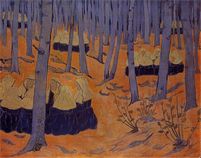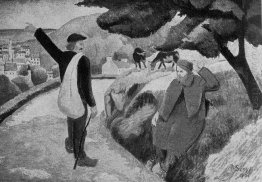Paul Serusier

Paul Sérusier (1864—1927) was a French painter.
Paul Sérusier was born in the year 1864 into a well-to-do middle-class family, his father was a successful businessman in the perfume industry who ensured that his son received a classical education. In 1875 Sérusier entered the Condorcet Lycée where he studied classical philosophy, Greek and Latin, and the sciences. He graduated from the lycée in 1883 with two baccaulaureats – in philosophy and in the sciences.
In 1885, after a short period of work in the company of his father's friend, Sérusier entered the Académie Julian to study art. Having a lovely disposition, he soon became popular both with students and professors. His lifelong friendship with Maurice Denis started at Académie Julian.
In 1888, Sérusier arrived at Pont-Aven in Brittany, a town popular among French and foreign artists. There, Sérusier's attention turned to a group of artists who crowded around émile Bernand and Paul Gauguin. Sérusier made their acquaintance and even received a lesson from Gauguin. Gauguin encouraged the young painter to release himself from the constraints of imitative painting, to use pure colors, not to hesitate to exaggerate his impressions, and to give to painting his individual decorative logic and symbolic system.
Sérusier returned to Paris with a small painting drawn under Gauguin's guidance, and enthusiastically showed it to his friends, sharing the new ideas that he learned from Gauguin. They called the painting, The Talisman (Le Talisman). Sérusier began active propaganda which, according to Maurice Denis, caused passionate debates among the students.
Together with the friends, Pierre Bonnard, Maurice Denis, Henri Ibels and Paul Ranson, who shared the new ideas, Sérusier formed a group, which they called les Nabis (Nabis is the Hebrew word for prophets). They met regularly to discuss theoretical problems of art, symbolism, occult sciences and esotericism. Later, Armand Seguin, Edouard Vuillard and Kerr-Xavier Roussel joined the group. However, after Gauguin's departure to Tahiti in 1891, the group fell apart and its members developed separately in different directions.
In the summer of 1892 Sérusier returned to Brittany and the small village of Huelgoat where he worked for two years. His painting subjects were Breton peasants with their figures monumental and solid. His palette changed, and he no longer used pure colors, but toned them down with gray.
Sérusier spent his winters in Paris working with his friend Lugné-Poe, founder of Théatre de l'Oeuvre. Many of the Nabis artists, Sérusier among them, participated in the scene decoration and costume design of the theater's Symbolist plays. By working on theater sets the artist tried out, on a large scale, their principles of simplification and the synthesis of the various means of expression.
In 1895, Sérusier accepted an invitation of his friend Jan Verkade to visit the Benedictine monastery of Beuron in Germany. The monk-artists of the monastery practiced a set of aesthetic principles according to which the laws of beauty were divine, mysteriously hidden in nature, and were revealed only to the artists who perceived the proportions and the harmony of sizes — God did everything in the Holy Spirit according to measurement, a number and weight.
The monks' doctrine appealed to Sérusier and upon his return to Paris he tried to convince his Nabi friends of their novelty and importance. The ideas met with no enthusiasm in Paris and Sérusier distanced himself from his former friends.
After several voyages to Beuron he settled in Brittany, and cultivated a painting style based primarily on calculations and measurements, and applied Beuton ideas to his Breton subjects.
He then studied Egyptian art, the Italian primitivists, and the tapestries of the Middle Ages to create decorative works of a mysterious and calculated timelessness.
From 1908, he taught regularly at the Ranson Academy.
In 1921 Sérusier published ABC of Painting, a short treatise in which he developed a theory of the curves and simple shapes, a theory of color and a method of research of the deafened colors. The book represented the summary of Sérusier's aesthetic research.





























































